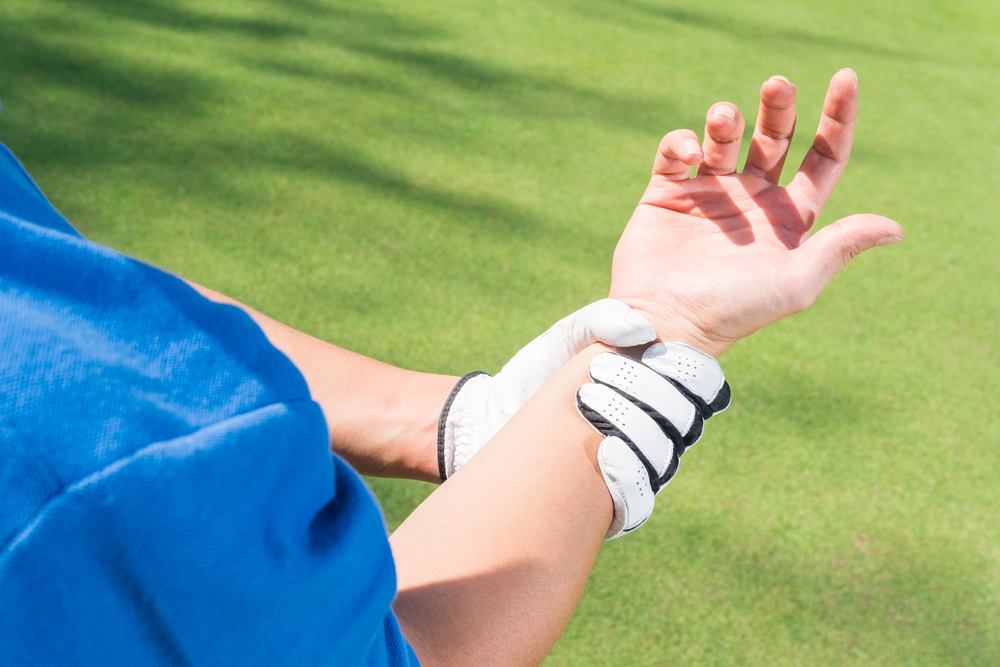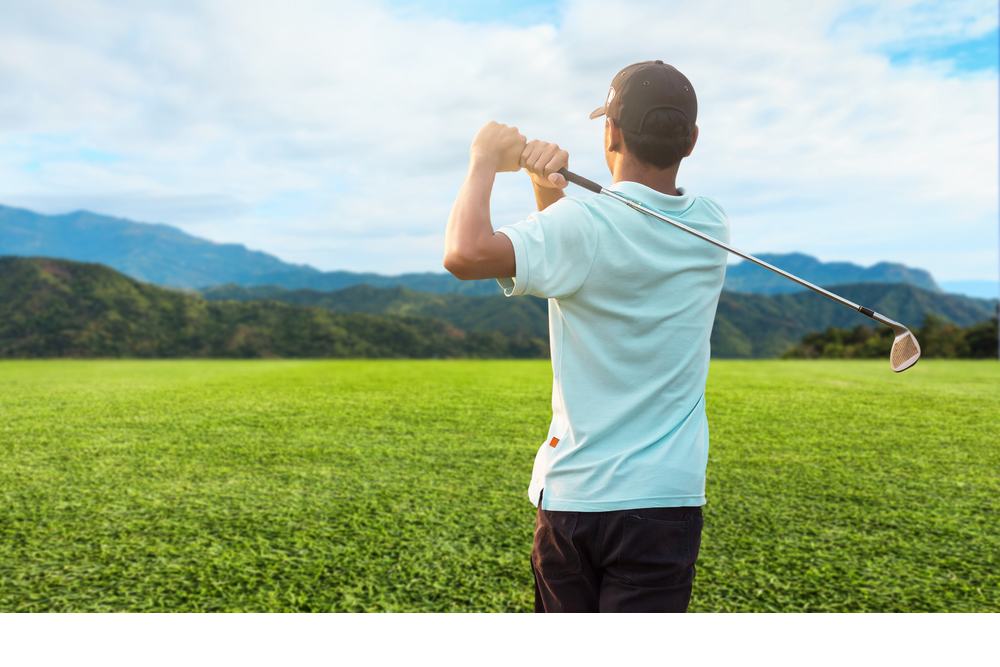 Golfing is a great activity that also allows you to socialize and enjoy low-impact exercise. When you play golf, you spend time outside walking the course and challenging yourself. Golf also helps keep your heart rate up and even offers mental health benefits like reducing stress and improving your confidence and self-esteem. The last thing you want to deal with is a golf injury keeping you from the sport you love. Even in a low-impact activity like golf, you are still at risk for injury. When you swing a golf club, you engage the whole body. However, your hands and wrists do a lot of work to help maintain the perfect swing and get your ball on the green. Wrist and hand injuries can cause pain and discomfort that can keep you from hitting the links for a while. Here are 3 common wrist and hand injuries that impact golfers, how to spot them, and how to prevent them in the future.
Golfing is a great activity that also allows you to socialize and enjoy low-impact exercise. When you play golf, you spend time outside walking the course and challenging yourself. Golf also helps keep your heart rate up and even offers mental health benefits like reducing stress and improving your confidence and self-esteem. The last thing you want to deal with is a golf injury keeping you from the sport you love. Even in a low-impact activity like golf, you are still at risk for injury. When you swing a golf club, you engage the whole body. However, your hands and wrists do a lot of work to help maintain the perfect swing and get your ball on the green. Wrist and hand injuries can cause pain and discomfort that can keep you from hitting the links for a while. Here are 3 common wrist and hand injuries that impact golfers, how to spot them, and how to prevent them in the future.
3 Common Golf Injuries of the Hand & Wrist
Your upper body takes on a lot of pressure when you are on the golf course. Golf-related injuries to the hands and wrists are more common than you might think. The way you grip your club and how you hold your wrists through the swing impact your success. These actions can also result in an injury when done improperly or with too much force. Here are 3 examples of common golf injuries that can affect the hands and wrists.
Tendonitis
Tendonitis refers to inflammation of tendons that connect muscles and bones in the body. When inflammation occurs in your hands and wrists, you may develop tendonitis. Six tendons help support mobility in each wrist, hand, and finger. When tendons in your wrists or hands become aggravated, it can cause an inflammatory response. If you start to experience an increase in wrist pain during or after golfing, then you might have tendonitis. The stress on your wrist from repeatedly swinging the club can cause tiny tears in your tendons. This can cause inflammation and pain as the body works to heal the area. Poor form while playing golf can also cause inflammation and make tendonitis worse. Tendonitis is a common wrist injury among golfers, especially if you do play frequently and do not give your hands and wrists enough time to rest in between trips to the golf course.
Sprained Wrist
A sprained wrist can occur when a ligament that connects two or more bones in your joint becomes stretched or torn. Many ligaments support your wrist and hand movements, and if they become overstretched or torn, it can impact the healthy functioning of the joint. This type of wrist injury can occur suddenly, like if you trip and hold your hands out to break your fall. Or you can develop a sprained wrist gradually because of stress and overuse of the wrist joint. When your muscles are tired, you are also at greater risk of suffering a sprain. A sprained wrist will typically cause pain, swelling, and inflammation. You may also see some bruising around the area. If you suffer a sprained wrist while playing golf, then you may notice instability or difficulty moving your hand or gripping objects, like your golf clubs.
Hand Fracture
A hand fracture can also occur from repetitive movements or as a sudden injury while golfing. The most common type of hand fracture golfers experience affects what is called the hook of hamate. The hamate refers to a bone on the pinky side of the wrist that is shaped like a wedge. This bone is located close to the ulnar nerve, which controls the function in the pinky finger. If the hook of hamate breaks, it can cause pain, tingling, and numbness that radiates into your ring and pinky fingers. If the ulnar nerve becomes aggravated or compressed due to the break, then it can also impact functioning in your palm and wrist. This type of hand fracture can make it difficult to grasp objects or flex your ring and pinky fingers.
Reducing Hand & Wrist Pain
If you start to experience hand and wrist pain during or after playing golf, then the first thing you want to do is take a break. You may need to cut back on the frequency of practicing and playing for a week or two while you allow your hands and wrists time to rest. Here are four ways you can reduce hand and wrist pain and prevent injury.
At-Home Remedies
The best thing you can do for wrist and hand pain is to rest the area. If any swelling or inflammation has occurred in your hand and wrist, then taking time to rest will allow your body the time it needs to jumpstart the natural healing process. In mild cases of hand or wrist pain, resting for a few days or a week may be enough to resolve your discomfort. Applying ice and heat to your wrists after playing a round of golf can also help. Cold compresses help restrict blood flow and decrease inflammation, while a heating pad can help relax tense muscles. Over-the-counter medications may help with pain and swelling in the area, though they do not address the underlying cause. If you notice your pain and other symptoms flare up when you play golf again, then you may want to talk to your doctor about other options for treating wrist and hand injuries.
Orthopedic Treatment
Visit an orthopedic doctor to learn more about how to relieve golf-related pain. Your orthopedic doctor can perform a physical evaluation to determine the source of your hand or wrist pain. Be sure to mention how often you golf, when you first noticed any symptoms, and whether certain movements make your pain worse. An orthopedic doctor can diagnose a wide range of hand and wrist injuries that can affect your golf game. Orthopedic treatment for hand and wrist injuries will involve diagnosing and addressing the root cause of your pain. Orthopedic doctors can provide hands-on treatments, write prescriptions, and even perform surgery when necessary.
Chiropractic Care
Chiropractic care takes an all-natural and drug-free approach to relieving pain and treating injuries. Visit your chiropractor for a potential wrist or hand injury from golfing and get started on treatment to help reduce your symptoms and restore healthy functioning. Your chiropractor will assess your affected hand and wrist, talk to you about when you notice pain and other symptoms, and develop a personalized treatment plan for you. In some cases, misalignments in your joints can make your symptoms worse. Chiropractors employ adjustments to help restore healthy functioning to joints, muscles, and other soft tissues in the body so you can function optimally. Chiropractors are well-known for treating back and neck issues, but they can also help with a wide range of musculoskeletal injuries and issues, like tendonitis that affects hands and wrists.
Physical Therapy
A physical therapist can support you through the recovery process of a wrist or hand injury. Physical therapists can also help you improve your strength, flexibility, and range of motion in your hands and wrists. Your physical therapist can even analyze your golf swing and provide you with pointers for how to improve your technique. Physical therapy involves a combination of stretches and exercises that allow you to take an active role in your recovery process. Your physical therapist will work with you to relieve sore, tight muscles and help you reduce your risk of further injury.
Improving Your Golf Swing
 Work with your doctor to improve your golf swing and help prevent future injuries that affect your hands, wrists, or the rest of your body. Incorporate a warmup into your golfing routine so you can get your muscles moving and better prepare for the activity ahead. Warming up before a round of golf will also help improve your golf swing and overall performance that day. Other ways to improve your golf swing include exercises that help you gain strength and flexibility. Strong muscles will better support a full-body swing and reduce your risk for injury. The more flexible you are, the less likely you are to strain or sprain any muscles, ligaments, or tendons. You can also work with a professional or coach to learn new techniques and how to adjust your swing for better overall performance.
Work with your doctor to improve your golf swing and help prevent future injuries that affect your hands, wrists, or the rest of your body. Incorporate a warmup into your golfing routine so you can get your muscles moving and better prepare for the activity ahead. Warming up before a round of golf will also help improve your golf swing and overall performance that day. Other ways to improve your golf swing include exercises that help you gain strength and flexibility. Strong muscles will better support a full-body swing and reduce your risk for injury. The more flexible you are, the less likely you are to strain or sprain any muscles, ligaments, or tendons. You can also work with a professional or coach to learn new techniques and how to adjust your swing for better overall performance.
Don’t let hand or wrist pain keep you from enjoying a game of golf. Visit your Atlanta doctor at AICA Orthopedics as soon as you notice any pain to avoid potential injury or issue. Our team of doctors includes orthopedic doctors, chiropractors, and physical therapists who work together to support whatever you need for a healthy recovery. We offer on-site diagnostic imaging tools to help diagnose any injuries, and you can meet with your team of doctors all in one convenient location. If you suffered a hand or wrist injury while playing golf, then our team of doctors at AICA Orthopedics is here to help.
